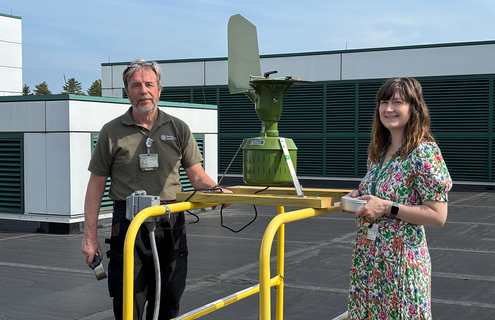
Feeling the pollen this spring?
Thanks to the efforts of Allergy and Clinical Immunology Specialist Erin L. Reigh, MD, MS, you can now stay informed about the region’s pollen count.
Reigh oversees a new pollen-counting station atop the roof of Dartmouth Hitchcock Medical Center (DHMC).
The station provides localized data about pollen. Reigh shares that data with the National Allergy Bureau (NAB) on the American Academy of Asthma & Immunology website, where the public can subscribe through My NAB to information about local pollen counts and access a dashboard.
The data collected includes pollen levels for trees, weeds, grass, and mold in the area.
How the local initiative started
Reigh got involved with the project last year.
Shortly before the annual meeting of the American Academy of Allergy, Asthma & Immunology, an NAB member reached out to her to oversee a new pollen counting station.
After completing a day-long aeroallergen certification course, passing a 70-question exam, and correctly counting a pollen sample, Reigh qualified to supervise it.
Reigh then worked with engineering over the summer to have one of the NAB's collection devices installed.
How the station works
The collection process has several steps.
The device samples mold spores and pollen grains by drawing air into the collector with an air pump.
Particles in the air land on a metal drum coated in a sticky film.
Reigh then removes the samples from the drum and observes and identifies them with a microscope.
The count is reported back to NAB for inclusion in its national tracking of environmental allergen levels and included on the site. There is a one-to-two-week delay between when the pollens are out and when the data is reported, due to the time needed to collect and process samples.
Why the new station matters
“A lot of pollen counting stations are also located in big cities, which is obviously a very different environment as well. I really wanted more accurate information for our patients,” Reigh says of her decision to get involved with the new station.
Previously, the closest station to New Hampshire was in Rochester, New York.
“We have a lot of people who come into our clinic. They're always telling us things like, ‘Oh, I heard the pollen is really bad this year. Worst ever. I really wanted to be able to say, yes or no. I wanted to be able to have more specific data for them,” she says.
How you might benefit
This season marks the first spring that the new pollen counter is providing data on local pollen counts. Reigh believes that as this data is collected, outcomes will improve for people dealing with seasonal allergies in the region.
“There are only about 60 active certified pollen-counting stations in the United States, which means the pollen counts that patients see on the news are sometimes gathered from stations hundreds of miles away,” Reigh said at the announcement of this new station last fall. “The pollen counting station is going to help us zero in on the most problematic allergens in our area."
The new station also means that she and other allergists may be able to better test and treat the specific allergies of patients in the region.
“The other thing that we might potentially be able to use here is when we put patients on allergy shots. My hope is that by seeing these pollen counts, we'll be able to tailor our treatments to make them more effective.”
To subscribe to allergen reports from the pollen counting station, visit the National Allergy Bureau page at the American Academy of Asthma & Immunology web site.
This article has been modified and updated following original publication under the title “Nothing to Sneeze at” in the November issue of Connections Magazine.